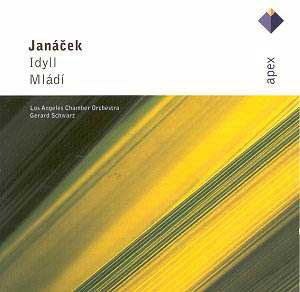Music from the beginning
and end of a creative life here; Janáček’s Idyll for
strings, composed in 1878 when he was just 24, coupled with his Mládí
– Youth – for woodwind sextet, written
around the time of his seventieth birthday. As you might expect, for
Janácek’s mature style took so long to emerge, in the Idyll
there are few hints of the later music. Indeed, as the booklet notes
point out, the work is shot through with the influence of Dvorák. Despite
the age difference, the two were good friends, and had gone on a walking
tour of Bohemia in 1877, the year Janáček conducted his older friend’s
Serenade for Strings. Perhaps the
vigorous fourth movement, with its short repetitive folk-dance phrases
is the only place where hints of the later Janáček may be felt,
but only faintly. The Idyll is undoubtedly an attractive
piece, however, with effective and idiomatic writing for the string
orchestra.
Mládí is another matter. It is
a truly original work of wind chamber music. In fact, there’s nothing
quite like it in the entire repertoire, though it’s a real surprise
that more composers haven’t used this particular line-up of the classic
wind quintet plus bass clarinet. The extra weight of this instrument’s
tone really transforms the medium, and makes balance within the ensemble
much less of a problem for players and audience.
It is not, however, an easy piece to play, and requires
unshakeable ensemble plus a degree of virtuosity from all six players.
The Los Angeles Chamber Orchestra players have the necessary qualities,
and they have clearly addressed with care all the challenges posed by
the work in its typically twitchy tempo changes and flurries of instrumental
colour. There will be those who might wish for a more ‘earthy’ sound
at times. On the other hand, there is some magically beautiful and expressive
playing; the last minutes of the superb Andante sostenuto are
a case in point. Great solo playing, but impeccable chording too.
I could wish for a greater sense of culmination in
the finale, which feels somewhat restrained. Nothing goes wrong, but
the ending seems tame. Nonetheless, both this and the Idyll receive
fine performances, and the recordings are of a suitable standard. In
fact Mládí is particularly well captured,
which is impressive when you realise how hard microphone placings are
for this kind of ensemble.
Gwyn Parry-Jones


![]() See
what else is on offer
See
what else is on offer 